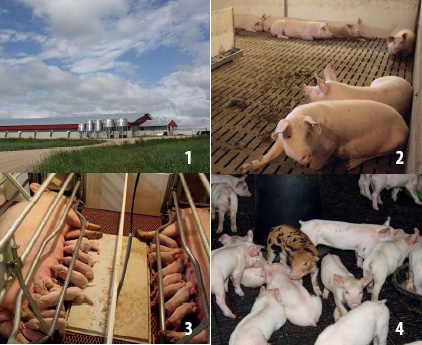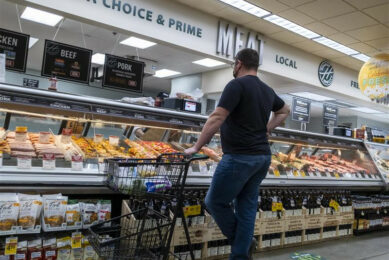Successful cross-border pig farming in North America

Producing finishers across the border sometimes comes with a lot of advantages. Canadian pork producer Rod Weenink, from Lacombe, Alberta, found himself a more cost-effective way of doing business by relocating his finisher sites to the United States – with a welfare bonus as a consequence.
1. One of the two Lilly Pork breeding facilities (Spruceville) 2. Dry sow housing in the Lacombe facility 3. Farrowing rooms 4. Piglets before being transported to the USA |
Talking about international pork production – Lilly Pork is definitely a good example. The 2,800 sow breeding facility, owned by Rod Weenink and his wife Lilly, can be found in two locations near the town of Lacombe in Alberta, Canada.
Finishing however, happens about a 24-hour drive south east of that – or 2,500 km. After weaning at 19 days, the pigs are transported to growing and finishing sites near Orange City, USA. Ten contract growers, together operating about 16 hog barns, take care of the pigs once in Iowa.
Together these facilities have a capacity of over 30,000 finishing places – sending more than 60,000 finishers to the US market every year.The two-nation strategy is more common among breeders in the more eastern province of Manitoba – Iowa is relatively close by for them. Weenink, although being located somewhat further to the Pacific, also decided to set up his own American business called South Pork Feeders about four years ago. The main reason for this partial relocation was cost of production. Weenink explains: “Our building costs [in Canada] are higher mostly because we have a colder climate with more expensive construction costs and more elaborate barns because of the climate. Traditionally US corn has been cheaper than Canadian feed grain supplies as usually we pay the US price plus the transportation costs.”
United States
Communication is easy, he explains – Weenink has continuous contact with his management company in Iowa through e-mail and phone to monitor business. About twice a year he travels down to Iowa to catch up face-to-face. The finishers are sold to the market at about 113-136 kg (250-300 pounds), depending on the weather conditions.
Weenink uses Genesus genetics to grow his own in-house pure breeds. On the female line, Weenink uses an F1 gilt, effectively a cross between Yorkshire, Large White and Landrace. Being provided by a Canadian genetics supplier helps, Weenink says, as the follow-up and service is around the corner, if needed. The farrowing happens in both facilities. In a 2,300 m2 (25,000 square feet) facility in Spruceville (picture 1), close to Lacombe, Weenink keeps about 160 sows in farrowing crates. This facility is also the place the piglets are picked up before their transport to the USA (picture 4).
Lacombe facility
The relocation of finishing to Iowa had a remarkable side effect with regard to sow housing at the farm’s main location near Lacombe. Before the relocation, Lilly Pork used to be a farrow-to-finish operation, with growers and finishers held in the Lacombe site of 10,200 m2 (110,000 square feet).
This site, however, was converted to become the place for all breeding and gestation and 240 more farrowing places when the last finishers had left Lilly Pork. Weenink decided to go for a rather effective and affordable way of converting the pig houses – he started to keep his sows in the identical liquid feeding group housing facilities. Hence, he started feeding his gestating sows on liquid feed containing wheat, barley, DDGS, soybean meal, canola meal, peas and of course water.
Weenink grins thinking of the unusual combination: “I’m probably one of the very few to keep sows in groups on liquid feed.” (picture 2)Despite considering gestation crates probably doing a better job with regard to aggression, Weenink says that liquid feed offers the means to feed a group of sows instantaneously. “For example, as fast as a fixed amount of liquid feed can run down the trough, all sows have the room and the proper amount of feed in front of them and available for their consumption at the same time. It does an acceptable job, as well as putting us in compliance with possibly future restrictions on gestation stalls.” He continues to say: “We group the sows as to breeding week, body condition and/or size which limits aggression to the first day or so. We hold sows in gestation stalls until positive breeding is confirmed by an ultrasound pregnancy checker, then they are grouped.”
Feed rations are all controlled via a feeding computer and feed curves, based on breeding days and body condition. In addition, factors like available barn space, available competitive feed ingredients and the outside temperature play a role in determining the least cost for feed rations.
COOL
Despite Weenink’s strategy, United States’ COOL legislation made the economic picture look somewhat complicated. COOL, short for Country-Of-Origin-Labeling, is American legislation which rules that on fresh beef, pork and lamb products it has to be clearly stated where the product originated from.
Especially producers in both Canada and Mexico are furious and anxious about this legislation, explaining it as protectionist, as American consumers would go for domestically produced meat when offered the choice. This stronger demand for American produce would in turn lead to higher prices for American producers. Not surprisingly, Canadian producers have often seen the opposite happening – they were confronted with discounts or even bans when their animals were sold to packers.As for Weenink, he said luckily COOL has not affected him that much. His animals are being sent for slaughter to a major US hog processor with which a multi-year supply, delivery and pricing contract has been made. Weenink is happy that he is treated the same as if he had had US pigs – and emphasises that the contract has been honoured from day one, both before and during COOL.Looking back, the move to the United States has been a good one, Weenink said. “Overall I am content. The hog pricing basis is more positive the closer the Canadian dollar gets to being on par with the US dollar and especially if the Canadian dollar goes above par. Available US risk management tools are more available and established and time proven as in Canada at this time. There are lots of marketing options as well. These are just a few of the advantages. The current downside is the US government’s ethanol policies that are artificially distorting the traditional feed cost comparisons. COOL did not stop Weenink from being successful, and it’s unclear how long COOL will continue to exist. Canada and Mexico jointly appealed the US legislation to the World Trade Organization (WTO), claiming the ruling has violated WTO standards. An interim ruling in May this year has already revealed that this legislation will be seen as ‘illegal’. It is yet unclear if this will lead to US adjustments or a repeal of the legislation. What is clear though, is that North America’s swine breeders will follow the process closely, whatever the outcome.
Lilly Pork technical data Total number of sows: 2,800 Total number of finisher places (USA): 30,000+ Total number of pigs sold to the US market: 60,000+/year Pigs weaned/sow/year: 25 Pre-weaning mortality: 11%; Post-weaning mortality: 6% Weaning: 19 days Sent for slaughter: 113-136 kg, weather-dependent ADG wean-to-growing (6-23 kg): 0.43 kg/day; FCR: 1.65 ADG grow to finish (23 kg and up): 0.82 kg/day; FCR: 2.85 Vaccination, sows: Parvovirus, E.coli Vaccination, piglets: PRRS |











